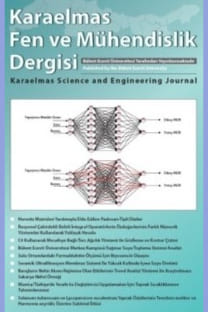The Effects of Microwave Energy to the Drying of Apple (Gala) Slices
Elma (Gala) Dilimlerinin Kurutulmasına Mikrodalga Enerjisinin Etkileri
___
Aktaş, M., Ceylan, I., Yılmaz, S. 2009. Determination of drying characteristics of apples in a heat pump and solar dryer. Desalination, 239: 266–758.Akyol, U., Kahveci, K. and Cihan, A. 2012. Effect of drying air pressure on cotton bobbin drying process. J. Int. Sci Publ. Materials, Methods and Technologies. 6(2): 198-204.
Albanese, D., Cinquanta, L., Russo, L., Crescitelli, S., Farina, M., Brasiello, A., Di Matteo, M. 2006. Modelling convective and microwave drying of potatoes slices. 13th World Congress of Food Science and Technology, Nantes, France.
Alibas, I. 2007. Microwave air and combined microwaveair drying parameters of pumpkin slices. LWT. 40. pp. 1445–1451.
Andres, A., Bilbao, C. and Fito, P. 2004. Drying Kinetics of Apple Cylinders Under Combined Hot Air-Microwave Dehydration. J. Food Eng.. 63: 71-78.
Arslan, D., Ozcan, MM. 2011. Study the effect of sun, oven and microwave drying on quality of onion slices. LWT - Food Science and Technology. 43: 1121-1127.
Aydogdu, A., Sumnu, G., Sahin, S. 2013. Infrared assisted microwave drying of eggplants. 4th International Conference on Food Engineering and Biotechnology IPCBEE IACSIT Press, Singapore DOI. 10.7763/IPCBEE. 50(2).
Bi, J., Yang, A., Liu, X., Wu, X., Chen, Q., Wang, Q., Lv, J., Wang, X. 2015. Effects of pretreatments on explosion puffing drying kinetics of apple chips. LWT - Food Science and Technology. 60: 1136-1142.
Çelen, S., Kahveci, K. 2013a. Microwave drying behavior of tomato slices. CJFS. 31 (2): 132-138.
Çelen, S., Kahveci, K. 2013b. Microwave drying behaviour of apple slices, Proceedings of the IMechE, Part E. Journal of Process Mechanical Engineering. 227(4): 264-272.
Darvishi, H., Asl, AR., Asghari, A., Azadbakht, M., Najafi, G., Khodaei, J. 2014. Study of the drying kinetics of pepper. JSSAS. 13: 130–138.
Dadali, G., Apar, DK., Ozbek, B. 2007. Microwave drying kinetics of ocra. Drying Technology. 25: 917–924.
Doymaz, İ., Tuğrul, N., Pala, M. 2006. Drying Characteristics of Dill and Parsley Leaves. J. Food Eng. 77(3): 559-565.
Erdem, T. 2006. Drying by microwave energy of washed red pepper by ozonated water. (MSc. Thesis.) University of Çukurova. Turkey. (in Turkish)
Ertekin, C., Yaldiz, O. 2004. Drying of eggplant and selection of a suitable thin layer drying model. J. Food Eng. 63: 349– 359.
Evin, D. 2012. Thin layer drying kinetics of Gundelia tournefortii L. Food Bioprod. Process. 90: 323–332.
Işık, E., Izli, N., Bayram, G., Turgut, I. 2011. Drying kinetic and physical properties of green laird lentil (Lens culinaris) in microwave drying. AJB. 10: 3841–3848.
Kassem, AS., Shokr, AZ., El-Mahdy, AR., Aboukarima, AM., Hamed, EY. 2011. Comparison of drying characteristics of Thompson seedless grapes using combined microwave oven and hot air drying. JSSAS. 10: 33–40.
Khatchatourian, OA. 2012. Experimental study and mathematical model for soya bean drying in thin layer. BSE. 113: 54- 64.
Kutlu, N., İşçi, A. 2014. Evaluation of thin-layer drying models for describing microwave drying of zucchini. 2nd International Congress on Food Technology, Kuşadası, TURKEY, November 05-07.
Maskan, M. 2000. Microwave/air and microwave finish drying of banana. J. Food Eng. 44: 71-78.
Menges, HO., Ertekin, C. 2006. Mathematical modeling of thin layer drying of Golden apples. J. Food Eng. 77: 119–125.
Meisami-asl, E., Rafiee, S., Keyhani, A., Tabatabaeefar, A. 2010. Determination of suitable thin layer drying curve model for apple slices (variety-Golab). POJ. 3(3): 103-108.
Mohammadi, B., Busaleyki, S., Modarres, R., Yarionsorudi, E., Fojlaley, M., Andik, S. 2014. Investigation of microwave application in agricultural production drying. IJTRA. 2 (1): 69-72.
Ozbek, B., Dadali, G. 2007. Thin layer drying characteristics and modeling of mint leaves undergoing microwave treatment. J. Food Eng. 83: 541–549.
Rayaguru, K., Routray, W. 2011. Microwave drying kinetics and quality characteristics of aromatic Pandanus amaryllifolius leaves. IFRJ. 18(3): 1035-1042.
Sarı, M., Karaaslan, S. 2014. Ananasın mikrodalga ile kurutulması ve uygun kuruma modelinin belirlenmesi. SDÜ Ziraat Fakültesi Dergisi. 9 (1): 42-50. (in Turkish)
Schössler, K., Jäger, H., Knorr, D. 2012. Effect of continuous and intermittent ultrasound on drying time and effective. J. Food Eng. 108: 103–110.
Toğrul, H. 2005. Simple modeling of infrared drying of fresh apple slices. J. Food Eng. 71: 311-323.
Vega-Galvez, A., Miranda, M., Diaz, LP., Lopez, L., Rodriguez, K., Di Scala, K. 2010. Effective moisture diffusivity determination and mathematical modelling of the drying curves of the olive-waste cake. Bioresour Technol. 101: 7265- 7270.
Wang, Z., Sun, J., Chen, F., Liao, X., Hu, X. 2007. Mathematical modeling on thin layer microwave drying of apple pomace with and without hot air pre-drying. J. Food Eng. 80: 536– 544.
Worknech, T.S., Raghavan, V., Gariepy, Y. 2011. Microwave assisted hot air ventilation drying of tomato slices. International Conference on Food Engineering and Biotechnology. 150– 161.
Zarein, M., Samadi, SH., Ghobadian, B. 2015. Investigation of microwave dryer effect on energy efficiency during drying of apple slices. JSSAS. 14: 41–47.
- ISSN: 2146-4987
- Yayın Aralığı: Yılda 2 Sayı
- Başlangıç: 2011
- Yayıncı: ZONGULDAK BÜLENT ECEVİT ÜNİVERSİTESİ
Kayaç Özelliklerine Bağlı Olarak Kayaç Delinebilirliğinin Yapay Sinir Ağları YSA Metodu ile Tahmini
Utku SAKIZ, Olgay YARALI, Hamit AYDIN
Otomotiv Endüstrisinde Yapay Sinir Ağı Kullanarak Maliyet Tahmin Modeli Geliştirme
ALİ OSMAN KUŞAKCI, BERK AYVAZ, Emir BEJTAGİC
Zonguldak ve Çevre Belediyelerde Geoteknik Hizmetlere Bakış
TEMEL ÖZTÜRK, Hıdır AYYILDIZ, Ergül MEYVACI, Melahat GÖKTAŞ
The Effects of Microwave Energy to the Drying of Apple (Gala) Slices
SONER ÇELEN, Ayşen HAKSEVER, AYTAÇ MORALAR
Üç Boyutlu Finsler Manifoldu F3 ’de Biharmonik Helisler
Elma Gala Dilimlerinin Kurutulmasına Mikrodalga Enerjisinin Etkileri
Soner ÇELEN, Ayşen HAKSEVER, Aytaç MORALAR
İnsansız Hava Araçları İçin Yapay Arı Kolonisi Algoritması Kullanarak
